Heating Effect of Electric Current-
Before you go through this article, make sure that you have gone through the previous article on Heating Effect of Electric Current.
We have learnt-
- When an electric current is passed through a conductor, it becomes hot & its temperature starts rising.
- This is called as heating effect of electric current.
- The amount of energy dissipated as heat in a conductor in time t is given by the formula-

In this article, we will learn about Electric Power.
Electric Power-
|
The rate at which an electrical appliance converts electric energy into other forms of energy is called its electric power.
OR Heat dissipated per unit time by an electrical appliance is called its electric power. |
Electric Power Formulae-
Consider-
- An electrical appliance having resistance R is connected across a source of emf.
- The source maintains a potential difference V across its ends and sends a steady current I.
This is shown below-
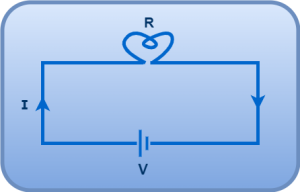
The electric power dissipated by the appliance is given by-
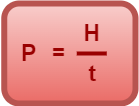
OR
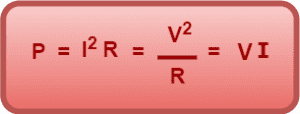
SI Unit of Electric Power-
| The SI unit of electric power is watt (W). |
1 W = 1 Js-1
The power of an electrical appliance is said to be one watt if it consumes one joule of energy per second.
Power Rating of Appliance-
| The power rating of an electrical appliance is the electrical power consumed by the appliance when connected across the marked voltage of the mains. |
Example-
Consider an electric bulb is rated as (100 W, 220 V).
- Here, the bulb has a rated power of 100 W and rated voltage of 220 V.
- It means that the bulb is meant to be used across a voltage of 220 V.
- And when it is used across 220 V, it consumes a power of 100 W.
In areas where there is a problem of low voltage, the bulbs with rating (100 W, 110 V) are used.
- This is even with a low voltage of 110 V, the bulb consumes a power of 100 W.
- So, the brightness of the bulb is not compromised.
- The problem with such bulbs is that when voltage becomes high, the bulb blasts.
- So, these bulbs are used only in those areas where there is a constant problem of low voltage.
Cases of Power Consumption-
Case-01: If VA = VR
In this case, the power consumed by an appliance is equal to the rated power i.e.

Here, PR is the rated power of the appliance
Case-02: If VA < VR
In this case, the power consumed by an appliance is less than the rated power and given by-
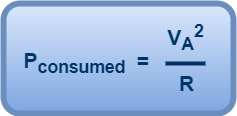
Here,
- VA = Applied Voltage
- R = Resistance of the appliance
Important NoteTo operate an appliance on voltage which is more than its rated voltage, a proper resistance has to be connected in series with it. |
Resistance of Appliance-
The resistance of an electrical appliance is calculated using the formula-
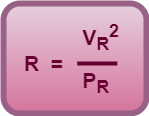
Here,
- VR = Rated Voltage
- PR = Rated Power
Brightness of Bulb-
- Brightness of a bulb depends upon the power consumed / dissipated by the bulb.
- The more the power dissipated by the bulb, the more is its brightness.
Test Your Concepts-
Get more notes & other study material of the Chapter Current Electricity.

